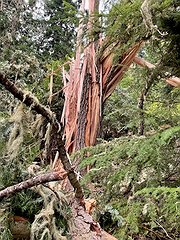'Lightning bust' to blame for recent North Idaho fires, but what does that mean?
In the wildland firefighting world, a weather phenomenon called a “lightning bust” poses a unique threat to firefighting efforts. Lightning busts refer to when a large number of wildfires are simultaneously started as a result of a lightning storm. Typically, these storm cells will roll into an area in the form of dry lightning events, with little to no precipitation accompanying them. These lightning busts are of particular concern because they may start fires within the first day after the storm front, but there is a high likelihood that a fire will not produce noticeable smoke until a few days after the event-- giving a fire ample opportunity to spread.
North-central Idaho's latest "lightning bust" event resulted in the Bluff Creek Complex and the Gwen Fire. When large incidents threaten values such as communities, properties, and local economies, difficult decisions are made to prioritize which incidents receive certain types of resources. This often depends on where crews will be most effective at protecting values at risk within a geographical area. So, what does that look like when initial attack resources show up to one of these “lightning bust” caused fires?
The initial attack stage during a lightning bust happens extremely quickly, with crews being dispatched to whatever smoke check was reported first. When arriving at the approximate location of one of these fires, either seeing or smelling the smoke is what will key firefighters in to where the fire might be. Once they locate the blaze, they tend to look for the “strike tree," or what the lightning contacted to start the lightning-caused fire. If there is a strike tree, it will typically look like it has been blown up, which can throw pieces of burning tree and ignite ground fuels to further carry fire spread.
Following these lightning busts, some fires may be concealed in wildlands for a few days or more-- when firefighters arrive on scene, they may come across the fire smoldering along the ground, or in some cases it has had days to spread into tree canopies. How well-established the fire is can greatly impact the outcome of initial attack, since it is impossible for a firefighter with a hand tool to contain a larger fire.
The goal is to catch these fires as early as possible so that firefighters can control and contain the fire before moving on to the next smoke report, but this process can take a serious toll on resources. Working often close to 16 hours each day, firefighters can become exhausted from the amount of new fire starts that a lightning bust can bring. Policy and good management ensure that work-to-rest ratios are maintained.
Lightning busts can cause what seems like an overwhelmingly large number of fire starts, but with the prompt, coordinated, diligent response from local resources, most of these fires do not extend past initial attack efforts.
Margaret "MJ" Miller is a Fire Information Specialist with the Nez Perce-Clearwater National Forest Supervisor's Office.



